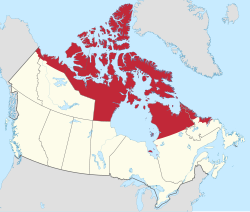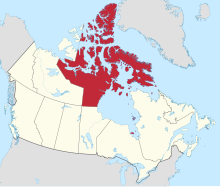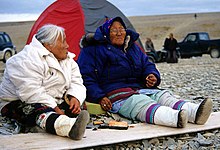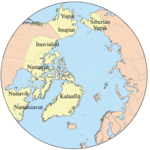Inuit Nunangat
Inuit Nunangat
ᐃᓄᐃᑦ ᓄᓇᖓᑦ | |
|---|---|
Inuit Regions of Canada | |
 | |
| State | Canada |
| Regions | Inuvialuit Nunangat, Nunavut, Nunavik, Nunatsiavut |
| Province/Territory | NWT, YK, NU, QC, NL |
| Area | |
| • Total | 3,304,740 km2 (1,275,970 sq mi) |
| • Land | 2,484,591 km2 (959,306 sq mi) |
| • Water | 820,149 km2 (316,661 sq mi) |
| Population | |
| • Total | 56,585 |
| • Density | 0.017/km2 (0.044/sq mi) |
| • Inuit | 47,335 |
| Time zone | UTC−08:00 (PST) UTC−07:00 (MST) UTC−06:00 (CST) UTC−05:00 (EST) UTC−04:00 (AST) |
| • Summer (DST) | Varies |
| Inuit languages (West to East) | Inuvialuktun Inuktut (Inuinnaqtun, Inuktitut) Atgangmuurngniq Inuttut |
| Website | www |
Inuit Nunangat (/ˈɪnjuɪtˈnunæŋæt/; Inuktitut syllabics: ᐃᓄᐃᑦ ᓄᓇᖓᑦ; lit. "lands, waters and ices of the [Inuit] people") is the homeland of the Inuit in Canada. This Arctic homeland consists of four northern Canadian regions called the Inuvialuit Settlement Region (Inuvialuit Nunangat, home of the Inuvialuit and the northern portion of the Northwest Territories), the territory Nunavut (ᓄᓇᕗᑦ), Nunavik (ᓄᓇᕕᒃ) in northern Quebec, and Nunatsiavut of Newfoundland and Labrador.
Etymology[]

Dorset | Innu |
Thule | Beothuk |
Norse |
Originally using the Greenlandic term "Nunaat" excluding the waters and ices, Inuit of Canada formally switched to the Inuktitut "Nunangat" in 2009 to reflect the integral nature "lands, waters and ices" have to Inuit culture.[5]
History[]
Inuit settlement[]
Aside from Métis, Inuit are the most recent Indigenous arrivals on the continent.
Inuit ancestors known as the Thule settled the Arctic replacing the previous dominant Dorset culture (Tuniit). The last remnant of Tuniit were Sadlermiut who disappeared in the early 1900s.
Inuit replaced the local Dorset culture over the course of around 200 years in the first millennium CE.
Displacement of the Tuniit ᑐᓃᑦ, or the Dorset people, and the arrival of the Inuit (whose ancestors are often called Thule) occurred in the 1100-1300s CE. Coming from Siberia where they split from the Aleut and other related peoples about 4,000 years ago, Inuit had reached Inughuit Nunaat in western Greenland by about 1300 CE, bringing with them transport dogs and various new technologies.
Trade relations were and remain strong with bordering countries and nations,[6] such as with the Gwich'in[7] and Chipewyan (Dënesųłı̨né)[8] of Denendeh and Innu of Nitassinan ᓂᑕᔅᓯᓇᓐ,[9] though occasional conflicts arose. Trade and relations with Europeans began with sparse Norse–Inuit contact and Basque trade with the southern NunatuKavummuit of NunatuKavut and the Nunatsiavummuit. Martin Frobisher's 1576 expedition to find the Northwest Passage landed on and around Baffin Island, in today's Qikiqtaaluk Region ᕿᑭᖅᑖᓗᒃ, where three Inuit, a man called Calichough (Kalicho), a woman, Egnock (Arnaq), and her child, Nutioc (Nuttaaq), were kidnapped and brought to the European continent, where they all died.[10][11][12][13]
The first treaty signed between Inuit and the Crown was in 1765 where NunatuKavut held negotiations over land use rights in Labrador. Around the same time, the Moravian Church set up missions supported by the English after altercations between NunatuKavut and colonial governments, with NunatuKavummuit's raids on whaling outposts ended by both treaties and the beginnings of harsh church control.
Canadian colonisation[]
Canadian colonisation extended in to Inuit Nunangat via the lands claimed as Rupert's Land, North-Western Territory and Quebec, later including Newfoundland and Labrador. Rapid spread of diseases, material wealth, the Christian churches and Canadian policing[14] saw a rapid decline and collapse of Inuit Nunangat, from which it is still recovering.
Since European colonisers had little desire to settle much of Inuit Nunangat's territories, the violence experienced by southern First Nations was comparatively minimal in the North. However, assimilation policies including the wide-scale slaughter of community dogs between 1950 and 1970,[15] the High Arctic relocation[16][17] as well as forced participation within the Canadian Indian residential school system[18] has left Inuit society with language loss and intergenerational trauma.[19]
Modern era[]
Today, Inuit Nunangat is overseen by the Inuit Tapiriit Kanatami (ᐃᓄᐃᑦ ᑕᐱᕇᑦ ᑲᓇᑕᒥ, meaning either "Inuit are united with Canada"[20] or "Inuit are united in Canada"[21]) which acts as a cultural centre piece and quasi-central government for Inuit affairs within Canada.
While Nunavut's confederation within Canada in 1999 via the Nunavut Act and Nunavut Land Claims Agreement is most visible, each of the regions of Inuit Nunangat as well as NunatuKavut have land claims with Canada. Nunangit came under the jurisdiction of the Inuvialuit Regional Corporation two years after the 1984 Inuvialuit Final Agreement, and Nunatsiavut was granted an autonomous government in 2005 after the 2002 Labrador Inuit Association proposal for a separate government. Beginning with a land claim in 1977, negotiations launched in 1988 between the Labrador Inuit Association, the governments of Newfoundland and Labrador and that of Canada. In Northern Quebec, the Makivik Corporation was established upon the James Bay and Northern Quebec Agreement signing in 1978, taking the mantle from the previous Nunavimmiut "Northern Quebec Inuit Association" (ᑯᐸᐃᒃ ᑕᕐᕋᖓᓂ ᐃᓄᐃᑦ ᑲᑐᔾᔨᖃᑎᒌᖏᑦ Kupaik Tarrangani Inuit Katujjiqatigiingit).
Finally, not formally within Inuit Nunangat is NunatuKavut whose treaty with the British extends back to 1765 and remains in force,[22] with the NunatuKavut Community Council (NCC) overseeing governance in this region.[23]
Demographics[]




As of the 2016 Canadian Census the population of Inuit Nunangat was 56,585. The Indigenous population is 49,020 or 86.63% and 47,335 (83.65%) are Inuit.[1][2][3][4]
| Region | Total | Inuit | First Nations | Métis | Other Indigenous | Non-Indigenous |
|---|---|---|---|---|---|---|
| Inuvialuit Settlement Region[1] | 5,330 | 3,110 | 860 | 130 | 25 | 1,205 |
| Nunavut[2] | 35,575 | 30,135 | 190 | 165 | 60 | 5,025 |
| Nunavik[3] | 13,125 | 11,800 | 135 | 30 | 30 | 1,130 |
| Nunatsiavut[4] | 2,555 | 2,290 | 25 | 35 | 0 | 205 |
| Totals | 56,585 | 47,335 | 1,210 | 360 | 115 | 7,565 |
Of those Inuit living in Inuit Nunangat 6.57% live in the Inuvialuit Settlement Region, 63.66% in Nunavut, 24.93% in Nunavik and 4.84% in Nunatsiavut.[1][2][3][4] In total there are 65,025 Inuit in Canada with 47, 335 (72.80%) living in Inuit Nunangat and 17,695 (27.21%) living in other parts of Canada.[24]
Communities[]
| Municipality | Region | Population |
|---|---|---|
| Iqaluit | Nunavut | 7,082 |
| Inuvik | Inuvialuit Settlement Region | 3,243 |
| Kuujjuaq | Nunavik | 2,754 |
| Rankin Inlet | Nunavut | 2,441 |
| Arviat | Nunavut | 2,318 |
| Baker Lake | Nunavut | 1,872 |
| Puvirnituq | Nunavik | 1,779 |
| Inukjuak | Nunavik | 1,757 |
| Cambridge Bay | Nunavut | 1,619 |
| Pond Inlet | Nunavut | 1,549 |
Inuvik is the regional centre for the Inuvik Region in the Northwest Territories and serves as a regional seat for the Inuvialuit Settlement Region. Iqaluit is the capital of Nunavut and Kuujjuaq for Nunavik. For Nunatsiavut, Hopedale (population 574[25]) is the legislative capital and Nain (population 1,125[26]) is the administrative capital.
There are six communities in the Inuvialuit Settlement Region, one town, Inuvik and five hamlets, Aklavik, Paulatuk, Sachs Harbour, Tuktoyaktuk and Ulukhaktok.
There are twenty-five populated communities in Nunavut.[27] One city, Iqaluit and twenty-four hamlets, Arctic Bay, Arviat, Baker Lake, Cambridge Bay, Cape Dorset, Chesterfield Inlet, Clyde River, Coral Harbour, Gjoa Haven, Grise Fiord, Hall Beach, Igloolik, Kimmirut, Kugaaruk, Kugluktuk, Naujaat, Pangnirtung, Pond Inlet, Qikiqtarjuaq, Rankin Inlet, Resolute, Sanikiluaq, Taloyoak and Whale Cove. In addition there is one uninhabited community recognised by the Government of Nunavut, Bathurst Inlet. Statistics Canada also recognises the uninhabited communities of Nanisivik and Umingmaktok.[28]

There are fourteen villages in Nunavik, Akulivik, Aupaluk, Inukjuak, Ivujivik, Kangiqsualujjuaq, Kangiqsujuaq, Kangirsuk, Kuujjuaq, Kuujjuarapik, Puvirnituq, Quaqtaq, Salluit, Tasiujaq and Umiujaq. All of these are northern village municipalities (TN) (Municipalité de village nordique) and, with the exception of Ivujivik and Puvirnituq, all have reserved lands associated.
There are five towns in Nunatsiavut, Hopedale, Makkovik, Nain, Postville and Rigolet.
Languages[]
There are multiple languages spoken across Inuit Nunangat. The oral languages form a vast dialect continuum with mutual intelligibility between neighbouring variants from the westernmost Iñupiatun dialect to the three Greenlandic languages: Kalaallisut, Tunumiisut, and, the closest variation to Canadian dialects, Inuktun. In Canada, there is Inuvialuktun spoken in the West in Inuvialuit Nunangat; Inuktitut, the most spoken dialect; Innuinaqtun which straddles the line between Inuktitut and Inuvialuktun; and Inuttitut spoken in the Labradorian East by Nunatsiavummiut. And, attested contemporarily only in a few Nunavut communities, Inuit Sign Language (also known as Atgangmuurngniq and Uukturausingit) continues to be passed down through generations regardless of deafness.[29] It is unknown by academia if there is any relation between Greenlandic and Inuit Sign Languages or if Greenlandic Sign Language is a dialect of Danish Tegnsprog.[30]
Within each of the primary oral language divisions (Inuvialuktun, Inuktut, and Inuttut), there exist several dialects therein. Within Inuvialuktun, the Siglit who live at the mouth of the Kuukpak speak Siglitun; and the Uummarmiut, or "people of the green trees" and are sometimes called "Canadian Iñupiaq," speak Uummarmiutun. Western Inuktut dialects are sometimes considered Inuvialuktun dialects, such as Inuinnaqtun (including one of its subdialects, Kangiryuarmiutun, spoken by the Copper Inuit group, the Kangiryuarmiut). Others include Natsilingmiutut, spoken by the Netsilik, with its sub-dialects including Utkuhiksalingmiutitut (the language of the "people of the place where there is soapstone": Utkuhiksalingmiut); Kivallirmiutut spoken by the Caribou Inuit of the Kivalliq Region; Aivilingmiutut of the Aivilingmiut; and the northern Qikiqtaaluk uannangani spoken by Iglulingmiut. On the southern part of Qikiqtaaluk around the Nunavut capital Iqaluit, Qikiqtaaluk nigiani is spoken, and relatively close is the dialect of Nunavik, Nunavimmiutitut, sometimes called Tarramiutut, Taqramiutut, or Inuttitut (not to be confused with Nunatsiavummiutut of Labrador). Nunavimmiutitut includes the subdialects spoken by the Tarrarmiut and Itivimuit. Nunatsiavummiut in Nunatsiavut, Labrador speak Inuttitut, Inuttut, or, alternatively, Labradorimiutut.
People[]
This section needs expansion. You can help by . (June 2019) |
Inuit are diverse peoples who share cultural and linguistic similarities. Moreover, they are a bimodal people, speaking both oral languages (Inuktut) and sign languages (Atgangmuurniq).
Peoples of Inuit Nunangat[]
- Nunavummiut
- Kivallirmiut
- Nunavimmiut
- Inuvialuit
- Nunatsiavummuit
Inuit outside Nunangat[]
- NunatuKavummuit
- Kalaallit/Inughuit/Tunumiit
- Iñupiaq
Related peoples[]
- Yup'ik
- Sugpiaq
Geography[]
This section needs expansion. You can help by . (June 2019) |
Spanning much of the North American Arctic, Inuit Nunangat is mostly above the tree line.
Climate change[]
Inuit Tapiriit Kanatami released in 2019 their National Inuit Climate Change Strategy to combat and respond to the ecological collapse and its effects on Inuit and Inuit Nunangat.[31]
Culture[]
This section needs expansion. You can help by . (June 2019) |
Inuit culture transcends millennia and includes numerous music styles, sports and other cultural attributes.
Inuit Nunangat has produced numerous contemporary bands and singers, such as Joshua Haulli, Quantum Tangle, The Jerry Cans ᐸᐃ ᒑᓚᖃᐅᑎᒃᑯᑦ (Pai Gaalaqautikkut), Elisapie ᐃᓕᓴᐱ, Aasiva, Tanya Tagaq, Riit ᕇᑦ, Qaunak Mikkigak, and Tumasi Quissa, as well as many others. Yearly, the features talented acts from across Inuit Nunangat, Canada, and the world, as one of many festivals that take place.
Inuit are world-renown for their use of soapstone, such as for carvings and for making qulliq ᖁᓪᓕᖅ. Although power tools are used, soapstone carving is often preferably done by axe and file.

The modern kayak originates from Inuit culture, originally called a qajaq ᖃᔭᖅ. As well, Inuit use the larger (6–12 m), wood-framed flat-bottomed umiaq for transporting people, goods, and dogs; and, on land, qamutik pulled by huskies or qimmiit, though Inuit have since transitioned to motorized forms of transport such as the Ski-Doo for navigating since the Canadian government massacred most of their sled dogs between the 1950s and 1970s in order to assimilate Inuit out of their traditional ways of life.[32]
Inuit cuisine, also known as "country food,"[33] incorporates a variety of meats (such as walrus, narwhal, bearded seal, caribou, polar bear, Arctic cod, and Arctic char, amongst others) and gathered plants (including crowberries, cloudberries, fireweed, seaweed, tubers and roots like mousefood, tuberous spring beauty, and sweet vetch)[34] Much of the meat is served frozen, raw, or boiled, much like sushi or sashimi in Japanese cuisine. Delicacies include akutuq ᐊᑯᑐᖅ, an ice cream-like dessert made with fat or tallow, meat, and mixed with berries;[35] igunaq ᐃᒍᓇᖅ, a year-long fermentation of select meats; maktaaq ᒪᒃᑖᖅ (alternatively maktak ᒪᒃᑕᒃ or maktaq), frozen whale skin and blubber usually eaten raw, sometimes pickled, and occasionally finely diced, breaded, deep fried, and then served with soy sauce; Labrador tea; and various dips such as aalu ᐋᓗ (intended for meat made from the choice parts of caribou or seal, chopped into tiny pieces and blended with melted fat and blood), misiraq ᒥᓯᕋᖅ (aged to resemble an aromatic white wine, made from seal or whale blubber), and nirukkaq ᓂᕈᒃᑲᖅ (a smooth made pâté made from the contents of a caribou’s stomach).[36]
Law[]
Inuit Nunangat currently functions through a variety of legal systems. As a Canadian jurisdiction, all of Inuit Nunangat falls under the federally overseen Criminal Code for criminal law. The regions within the three territories: Inuvialuit Nunangat in the Northwest Territories and Yukon, and Nunavut, are all subject to the English common law tradition. Nunavik, falling under the jurisdiction of Québec, follows the civil law tradition as it pertains to private law. Finally, Inuit largely still follow Inuit Qaujimajatuqangit traditions, recognizing the interconnected nature of reality.
Inuit Qaujimajatuqangit ᐃᓄᐃᑦ ᖃᐅᔨᒪᔭᑐᖃᖏᑦ (alternatively rendered Qaujimanituqangit or Qauyimayatuqangit) comes from the root word qaujima- ᖃᐅᔨ meaning "to know," and could be literally translated as "that which has long been known by Inuit." Leaders and Elders did not see themselves as agents of social control or law and order, as each individual contributes to the functioning of the community.[37] The integration of Inuit Qaujimajatuqangit (or IQ) and the wider Canadian legal tradition is an ongoing process. For example, the Nunavut Court of Justice is the only "unified," single-level court in Canada, and the court travels to communities every six weeks to two years. There are also on-the-land and contemporary healing circle programs administered.[38]
See also[]
References[]
- ^ a b c d "Aboriginal Population Profile, 2016 Census Inuvialuit region [Inuit region], Northwest Territories". Statistics Canada. Government of Canada. Retrieved 6 September 2019.
- ^ a b c d "Aboriginal Population Profile, 2016 Census Nunatsiavut [Inuit region], Newfoundland and Labrador". Statistics Canada. Government of Canada. Retrieved 6 September 2019.
- ^ "Maps Of Inuit Nunangat (Inuit Regions Of Canada)". Inuit Tapiriit Kanatami ᐃᓄᐃᑦ ᑕᐱᕇᑦ ᑲᓇᑕᒥ. ITK. Retrieved 20 June 2019.
- ^ "Inuit Trade in the Central Arctic". Inuit contact and colonization. Inuit Heritage Trust. Retrieved 20 June 2019.
- ^ Black, Scott; Montgomery, Georgina; Fehr, Alan, eds. (2002). Canada's Western Arctic (PDF). Inuvik, Denendeh/Nunangit, Canada: Western Arctic Handbook Committee. p. 342. ISBN 0-9687910-0-X. Retrieved 20 June 2019.
- ^ Csonka, Yvon (1999). "A stereotype further dispelled: Inuit-Dene relations west of Hudson Bay, 1920–1956". Études/Inuit/Studies. 23 (1/2): 117–144. JSTOR 42870948.
- ^ "Innu Culture". Heritage Newfoundland and Labrador. Heritage Newfoundland and Labrador. Retrieved 20 June 2019.
- ^ Renée Fossett (2001). In Order to Live Untroubled: Inuit of the Central Arctic, 1550-1940. Univ. of Manitoba Press. p. 37. ISBN 978-0-88755-328-8.
- ^ "The Death of the Inuit Man in England: Postmortem report and comments of Dr. Edward Dodding (Excerpts)" (PDF). National Humanities Center. 2006.
- ^ Karen Ordahl Kupperman (30 June 2009). The Jamestown Project. Harvard University Press. p. 94. ISBN 978-0-674-02702-2.
- ^ Vaughan, Alden T. "American Indians in England (act. c.1500–1615)". Oxford Dictionary of National Biography (online ed.). Oxford University Press. doi:10.1093/ref:odnb/71116. (Subscription or UK public library membership required.)
- ^ Bonesteel, Sarah (June 2006). Canada's Relationship with Inuit: A History of Policy and Program Development (Report). Indigenous and Northern Affairs Canada. ISBN 978-1-100-11121-6.
- ^ Qikiqtani Inuit Association (April 2014). Qimmiliriniq: Inuit Sled Dogs in Qikiqtaaluk (PDF) (Report). Toronto, Ontario: Qikiqtani Inuit Association. ISBN 978-1-927095-63-8.
- ^ The High Arctic Relocation: A Report on the 1953–55 Relocation by René Dussault and George Erasmus, produced by the Royal Commission on Aboriginal Peoples, published by Canadian Government Publishing, 1994 (190 pages)"Archived copy". Archived from the original on 1 October 2009. Retrieved 9 October 2009.
{{cite web}}: CS1 maint: archived copy as title (link) - ^ Porteous, John Douglas; Smith, Sandra Eileen (2001). Domicide: The Global Destruction of Home. McGill-Queen's Press. pp. 102–03. ISBN 978-0-7735-2258-9.
- ^ Elgar, Margaret Fern (19 September 1997). A Comparative Study of Native Residential Schools and the Residential Schools for the Deaf in Canada (PDF) (Thesis). Carleton University. Retrieved 20 June 2019.
- ^ "Reclaiming Power and Place: The Final Report of the National Inquiry into Missing and Murdered Indigenous Women and Girls". mmiwg-ffada. National Inquiry into Missing and Murdered Indigenous Women and Girls. Retrieved 20 June 2019.
- ^ postscript on Aboriginal Titles, Katherine Barber, Government of Canada Translation Service"
- ^ We are the national voice of Canada’s 65,000 Inuit.
- ^ "British-Inuit Treaty of 1765". NunatuKavut Our Ancient Land. NunatuKavut. Retrieved 20 June 2019.
- ^ "Our Governance". NunatuKavut Our Ancient Land. NunatuKavut. Retrieved 20 June 2019.
- ^ Inuit population by residence inside or outside Inuit Nunangat, 2016
- ^ "Hopedale, Town [Census subdivision], Newfoundland and Labrador and Division No. 11, Census division [Census division], Newfoundland and Labrador". Statistics Canada. Government of Canada. Retrieved 6 September 2019.
- ^ "Nain, Town [Census subdivision], Newfoundland and Labrador and Division No. 11, Census division [Census division], Newfoundland and Labrador". Statistics Canada. Government of Canada. Retrieved 6 September 2019.
- ^ "Community Information - Government of Nunavut". www.gov.nu.ca. Retrieved 7 October 2019.
- ^ "Population and dwelling counts, for Canada, provinces and territories, and census subdivisions (municipalities), 2016 and 2011 censuses – 100% data (Nunavut)". Statistics Canada. 20 February 2019. Retrieved 7 October 2019.
- ^ MacDougall, Jamie (February 2001). "Access to justice for deaf Inuit in Nunavut: The role of "Inuit sign language"". Canadian Psychology. 41 (1): 61.
- ^ Brentari (2010) ed. Sign Languages, p. 82
- ^ "National Inuit Climate Change Strategy Sets Out Coordinated Actions To Shape Climate Policy". Inuit Tapiriit Kanatami ᐃᓄᐃᑦ ᑕᐱᕇᑦ ᑲᓇᑕᒥ. Retrieved 23 June 2019.
- ^ "Inuit dog killings no conspiracy: report". Canadian Broadcasting Corportation. CBC News. 20 October 2010. Retrieved 13 January 2022.
- ^ Robinson, Amanda. "Country Food (Inuit Food) in Canada". The Canadian Encyclopedia. Historica Canada. Retrieved 13 January 2022.
- ^ Inuit Tapiriit Kanatami. "Arctic Wildlife". Archived from the original on 13 August 2007. Retrieved 20 November 2007.
Not included are the myriad of other species of plants and animals that Inuit use, such as geese, ducks, rabbits, ptarmigan, swans, halibut, clams, mussels, cod, berries and seaweed.
- ^ "Nunavut — Food and Restaurants". iExplore. Retrieved 13 January 2022.
- ^ "The Traditional Foods of the Inuit" (PDF). IsumaTV. Retrieved 13 January 2022.
- ^ "Inuit Qaujimajatuqangit". Department of Culture and Heritage. Government of Nunavut. Retrieved 13 January 2022.
- ^ "The Traditional Inuit Justice System" (PDF). Retrieved 14 August 2021.
External links[]
- Indigenous peoples in Atlantic Canada
- Indigenous peoples in Northern Canada
- Indigenous peoples of North America
- History of indigenous peoples of North America
- Hunter-gatherers of the Arctic
- Hunter-gatherers of Canada
- Hunter-gatherers of the United States
- Eskimos
- Inuit
- Indigenous peoples in the Arctic
- Cultural regions

